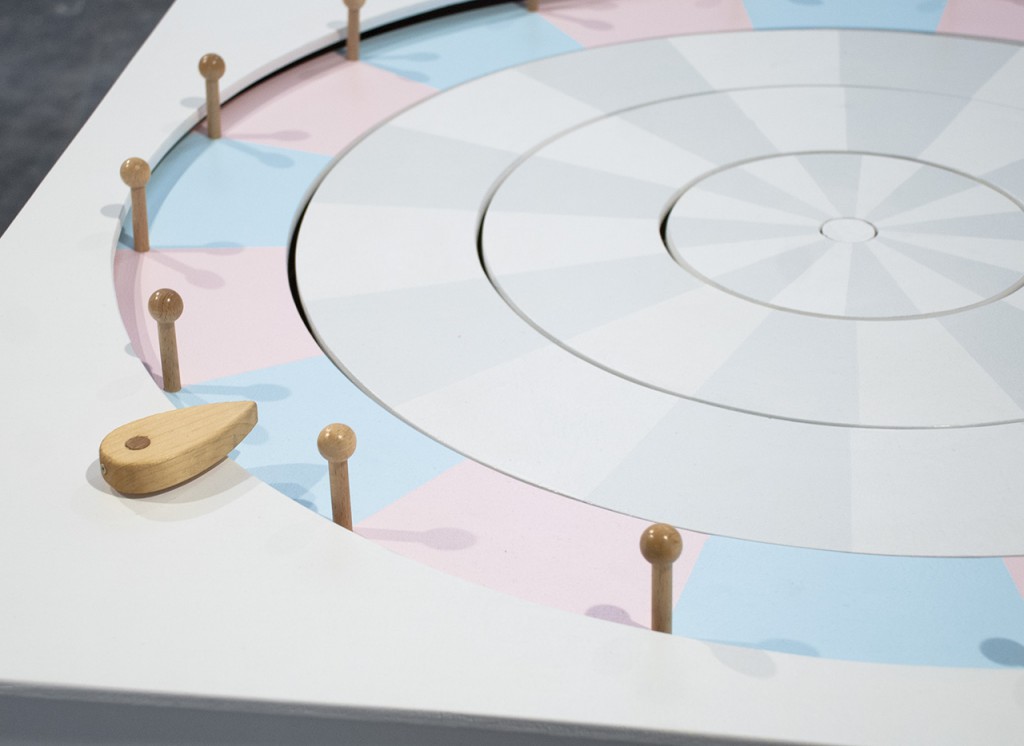Unidirectional
Already from birth we label the baby with either the pink or the blue color – but what do we really know about this person’s future gender identity, gender expression or sexual orientation?
In my research of the gender topic I’ve realized how we tend to simplify the question of gender in the society but also the limitations of my own knowledge. This wheel represents today’s stereotypical use of the two traditionally used genders: man and woman, with a lack of understanding of the three inner circles. These white and grey circles represents gender identity (a persons own feelings about their gender), gender expression (how a person express themselves through clothes, makeup, stance and manner etc) and sexual orientation. Although we know nothing about these things when a baby is born, we still tend to dress them – and treat them – after their penis or vagina.
Rotating wooden wheel, 110×110 cm
In a broader perspective this spinning wheel connects to the ideas of the American philosopher John Rawls (1921–2002) and his theory about the veil of ignorance. Rawls presents us with the idea that the must equal society would be based on rules set up behind a veil of ignorance. No one could then tailor the rules for their own advantage:
”…no one knows his place in society, his class position or social status, nor does anyone know his fortune in the distribution of natural assets and abilities, his intelligence, strength, and the like. I shall even assume that the parties do not know their conceptions of the good or their special psychological propensities. The principles of justice are chosen behind a veil of ignorance.” (John Rawls, A Theory of Justice, 1971)
This idea, Rawls means, should lead to the must just society, a world that is fair to all. If you do not know how you will end up in your own dream world you will be likely to give equal rights to one and all.
I see this veil of ignorance as a sort of a lottery, a roulette or a wheel of fortune. When we see a newborn baby we usually know exactly where this kid was born, the economical situation of its parents, the color of its skin and if it has a penis or a vagina. But why not be open about the bits we do not know?

Unidireccional
Ya desde el nacimiento, designamos a un bebé con el color rosa o el azul, pero… ¿Qué sabemos nosotros de la futura identidad de género, expresión de género u orientación sexual de esta persona?
En mi investigación sobre el tópico de género me he dado cuenta como tendemos a simplificar la cuestión de género en la sociedad, pero también las limitaciones de mi propio conocimiento. Esta rueda representa el uso estereotipado de los dos géneros usados tradicionalmente: hombre y mujer, con una falta de entendimiento de los tres círculos internos. Estos círculos blancos y grises representan la identidad de género (los sentimientos de una misma persona sobre su género), la expresión de género (cómo las personas se expresan a través de la ropa, el maquillaje, la actitud y los modales etc.) y la orientación sexual. Aunque no sabemos nada de esto cuando un bebé nace, seguiremos tendiendo a vestirlo – y a tratarlo – dependiendo de su pene o vagina.
Rueda rotatorio de madera, 110×110 cm
En una perspectiva más amplia, esta rueda conecta con las ideas del filósofo americano John Rawls (1921-2002) y su teoría acerca del velo de la ignorancia. Rawls nos presenta la idea de que una sociedad igualitaria estaría basada en unas reglas establecidas detrás de un velo de ignorancia. Nadie, de esta manera, podría establecer las reglas por su propio beneficio:
“…nadie conoce su lugar en la sociedad, su posición de clase o estatus social, y tampoco nadie conoce su suerte en la distribución de activos y habilidades naturales, su inteligencia, su fuerza, y cosas similares. Asumiré incluso que las partes no conocen sus concepciones del bien o sus propensiones psicológicas particulares. Los principios de justicia se eligen detrás de un velo de ignorancia.” (John Rawls, Teoría de la justicia, 2006)
Esta idea, según Rawls, debería de llevarnos a una sociedad justa, un mundo justo para todos. Si no sabes cómo vas a acabar en tu propio mundo ideal, les darías los mismos derechos a todos.
Yo veo este “velo de ignorancia” como una especie de lotería, una ruleta, o una rueda de la fortuna. Cuando vemos un recién nacido, sabemos normalmente con exactitud dónde nació este niño, la situación económica de sus padres, el color de su piel, y si tiene pene o vagina. Pero, ¿porqué no abrirnos un poco a lo que no sabemos?
